AMY KHOSHBIN
Amy Khoshbin’s collages and sculptures draw parallels between the hierarchy of the corporate office and the current state of electoral politics in 2020 America, where wealth and influence intersect. She juxtaposes imagery from her late Iranian immigrant father’s corporate workplace with traditional cultural symbols of power and symbols of progressive leadership. In her performance and video work, Khoshbin aims to build bridges between disparate communities to counteract fear with a sense of empowered radical acceptance.
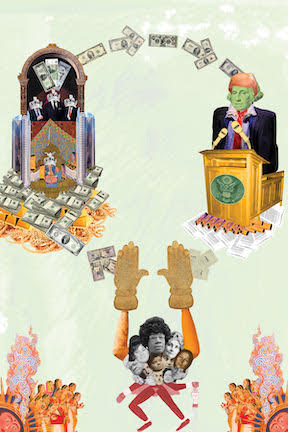
Break the Cycle (2020)
Break the Cycle reflects powerful female politicians and activists helping stop the cycle of wealth yielding power, especially in the realm of electoral politics. This digital collage uses imagery from Persian miniature painting, historic and current portraits of female-identified politicians and activists such as Shirley Chisholm and Ida B. Wells, and symbols of wealth to present a picture of political power that has the capability to change if we mobilize and step forward.
Giclee print of collage on paper, 20” x 30”
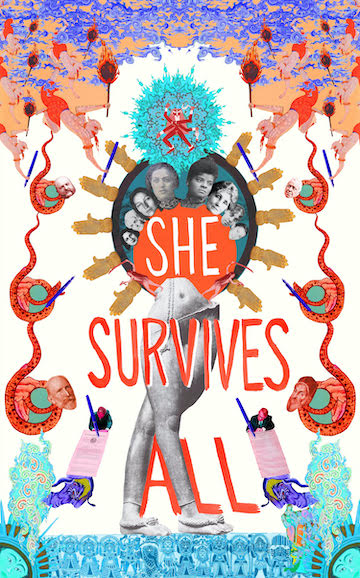
She Survives All (2020)
She Survives All reflects the legacy, resilience, and power female-identified people carry forward in the face of systemic oppression throughout time. This print of a handmade collage uses imagery from Persian miniature painting, ancient representations of Hindu goddesses, historic and current portraits of female-identified women’s rights activists and the artist’s family to present a divine feminine personal/political power that survives beyond pasts, presents and futures.
Throughout history, legislation usually written by men has defined what constitutes women’s rights and the legal control we have over our bodies. In She Survives All, the iconography, gestures, and figures behind these laws are embedded as antagonistic historical mythology within the collage. Several anti-abortion Popes become snake-like figures alongside Anthony Comstock and the stack of paper representing his Comstock Act of 1873, which criminalized abortion and birth control among many other necessary women’s rights he deemed “obscene.” The pen is mightier than the sword in continuing to perpetuate systemic misogyny in 2020 America, as we see abortion bans being signed into law across the country. The optics around the moment of signature is media iconography to represent the erosion of rights– two such moments are included in the collage.
Countering these attacks against women is the ancient/modern goddess figure in the center, surrounded by the protective hand of Fatima. The goddess is grounded with the legs and center representation of Kali, the Hindu Divine Mother who destroys evil forces. Atop Kali sit the heads of women’s rights activists Mary Dennett, Ida B Wells, Sediqeh Dowlatabadi, Ruth Bleier, and Carmen Barroso pictured alongside the artist’s mother, grandmother, and aunt, acknowledging the power of historical legacy both personally and politically.
Giclee print of collage on paper, 20” x 30”
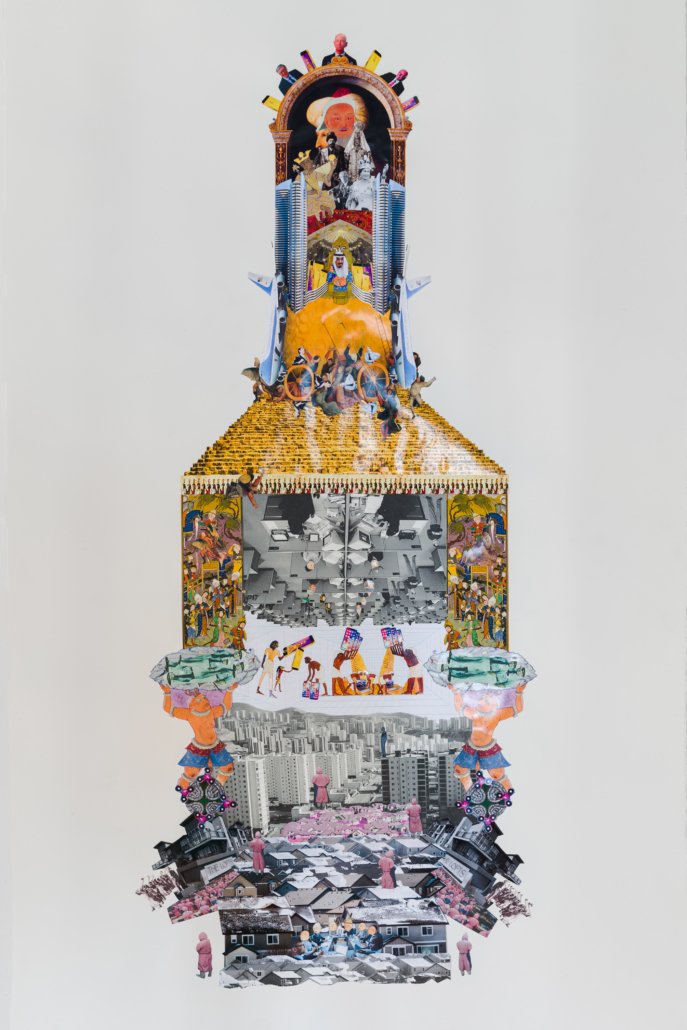
Power (2019)
Power shows the cycles of wealth, domination, labor, and land ownership throughout history, starting at the top of the image depicting the three wealthiest people in the world as of 2019: Jeff Bezos, Bill Gates, and Warren Buffett. Below them are a series of the wealthiest historical figures and largest landowners, including Ghengis Khan, Mansa Musa, and Queen Elizabeth.
This handmade collage uses spatial hierarchy to represent status along with imagery of absurd status symbols towards the top of the piece, like the iPhone Black Diamond– an outdated iPhone 5 that sold for $15 million dollars– in juxtaposition with depictions of labor through time below from Bosch’s The Haywain Triptych to Persian and Egyptian Miniatures to images of cubicles from the internet. Real estate– the largest industry in the United States by revenue– is reflected in the images of mass-produced housing towards the bottom of the piece.
Real estate wealth is also reflected in America’s president in 2019 and Power implicates his actions into the perpetuated cycle of wealth, domination, and oppression in our current political climate.
Handmade Collage, 81” x 36”
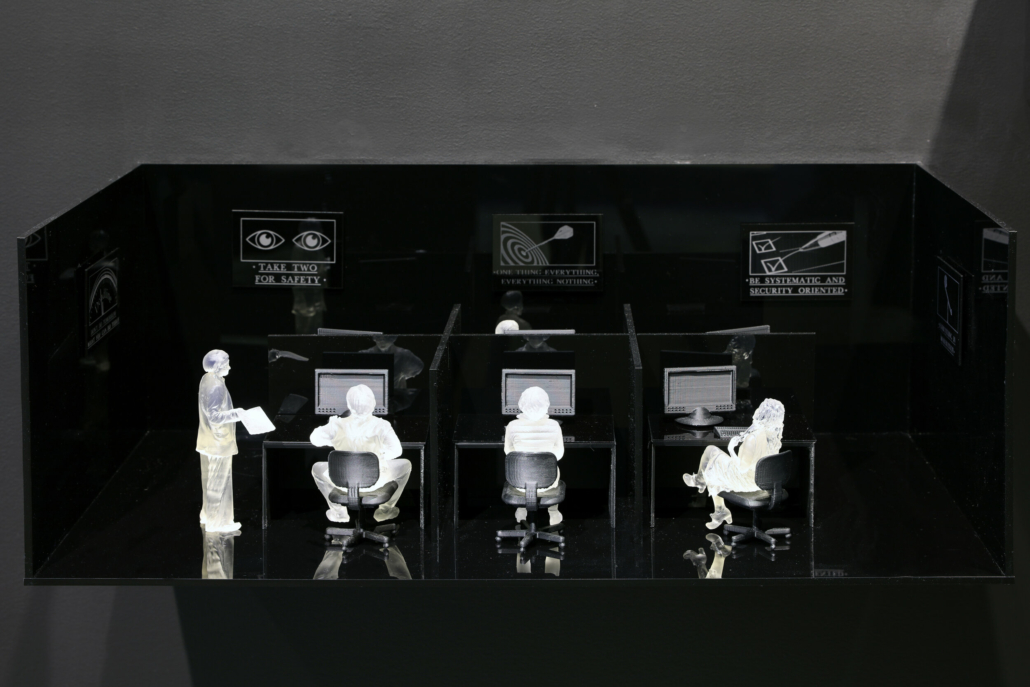
Modern Work Dioramas: Manager + Team (2019)
In Manager/Team, the systematized isolation found in the modern-day corporate work environment is represented through 3D-printed dioramas of Amy Khoshbin’s father, Djam Khoshbin’s office where the artist embodies all the characters. These pieces are inspired by Egyptian Middle Kingdom (2030- 1650 BCE) wooden models depicting hierarchical labor and commerce systems. The walls in Modern Work Dioramas are adorned with corporate motivational posters that feature unique idioms by the artist’s father.
Collaboration with Keary Rosen, Joseph Labib, and Form Design Lab Rutgers
3D-printed Resin, PLA, Plexiglas 10″ H x 29″ L x 15″ D
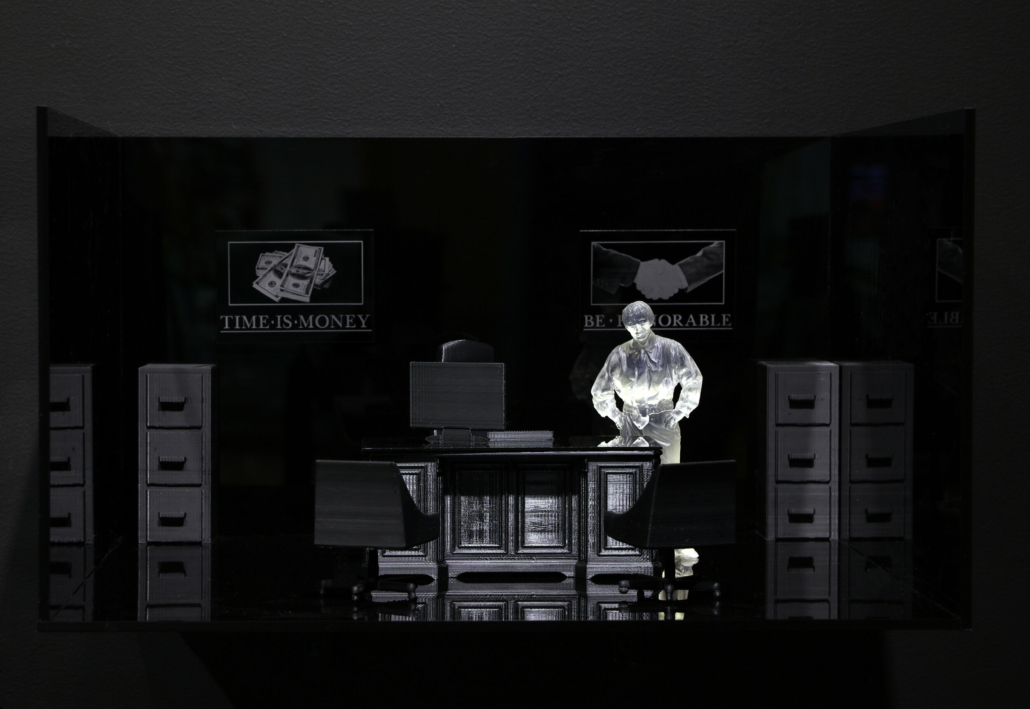
Modern Work Dioramas: Manager + Team (2019)
In Manager/Team, the systematized isolation found in the modern-day corporate work environment is represented through 3D-printed dioramas of Amy Khoshbin’s father, Djam Khoshbin’s office where the artist embodies all the characters. These pieces are inspired by Egyptian Middle Kingdom (2030- 1650 BCE) wooden models depicting hierarchical labor and commerce systems. The walls in Modern Work Dioramas are adorned with corporate motivational posters that feature unique idioms by the artist’s father.
Collaboration with Keary Rosen, Joseph Labib, and Form Design Lab Rutgers
3D-printed Resin, PLA, Plexiglas 10″ H x 18″ L x 15″ D
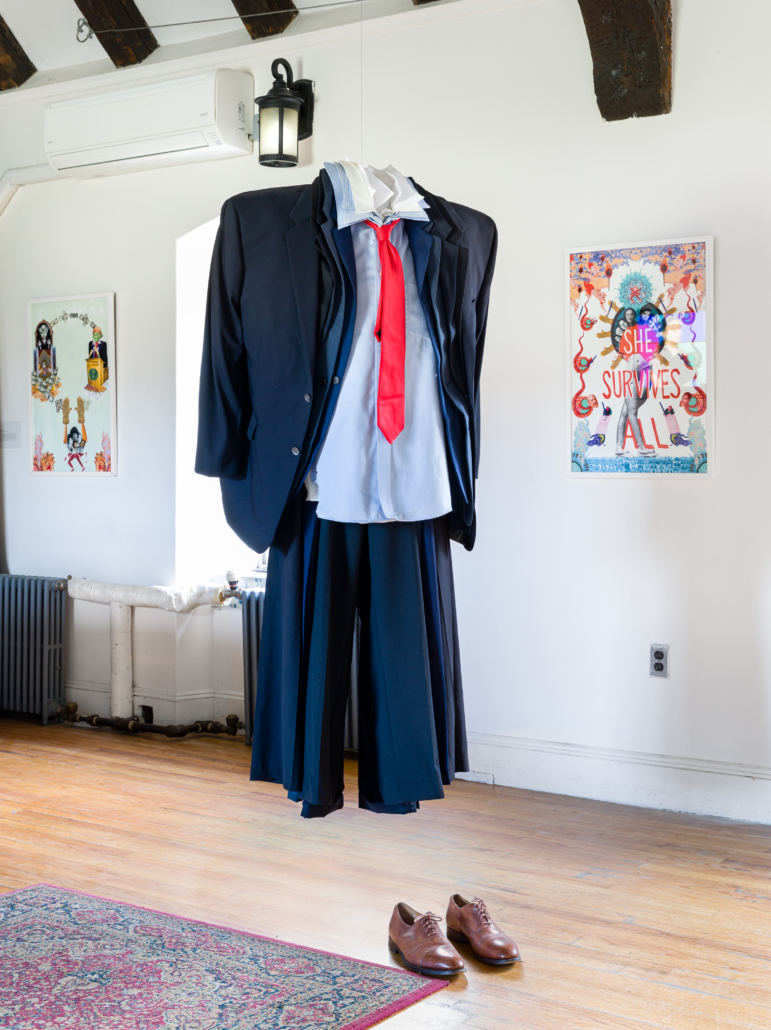
Corporate Body (2019)
This sculpture and the related dioramas were originally featured in Khoshbin’s solo exhibition GHOSTS (2019) at Project for Empty Space.
Together these works explore ideas of grief, loss, greed, chaos, and corruption from the personal to the political. The artist enters into the conversation via the lens of her own story, with the recent loss of her father, Djam Khoshbin. Exploring legacy by using his personal artifacts and distinctive advice as source material, Khoshbin reflects on the universal and specific methodologies of memorialization– the archives and subsequent mythologies we leave behind. Specific books that formed her father’s ideology, such as Passages and Executive Time Management, become guides in traversing not only an Iranian father’s immigrant history as a manager in corporate America, but also larger ideas of migration, belonging, and the failure of the American dream.
Tailored business suits, artist’s father Djam Khoshbin’s suit, football padding, 30” W x 6” H x 20” D
ABOUT THE ARTIST
Amy Khoshbin @tinyscissors is an Iranian-American Brooklyn-based artist, activist, and educator. Her practice, as an artist and pedagogue, builds bridges between disparate communities to counteract fear with a collective sense of empowered radical acceptance. She pushes the formal and conceptual boundaries of artmaking to foster progressive social change through performance, social practice, video, rap music, installation, tattooing, teaching and writing.
